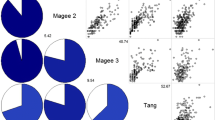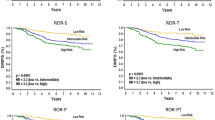Abstract
Oncotype DX® is a gene expression assay that quantifies the risk of distant recurrence in patients with hormone receptor positive early breast cancer, publicly funded in Ireland since 2011. The aim of this study was to correlate Oncotype DX® risk groupings with traditional histopathological parameters and the results of other risk assessment tools including Recurrence Score-Pathology-Clinical (RSPC), Adjuvant Risk Index (Adj RI), Nottingham Prognostic Index (NPI) and the Adjuvant! Online 10-year score (AO). Patients were retrospectively identified from the histopathology databases of two Irish hospitals and patient and tumour characteristics collated. Associations between categorical variables were evaluated with Pearson’s chi-square test. Correlations were calculated using Spearman’s correlation coefficient and concordance using Lin’s concordance correlation coefficient. Statistical analysis was performed using SPSS software, version 22.0.
In our 300 patient cohort, Oncotype DX® classified 59.7% (n = 179) as low, 30% (n = 90) as intermediate, and 10.3% (n = 31) as high risk. Overall concordance between the RS and RSPC, Adj RI, NPI, and AO was 67.3% (n = 202), 56.3% (n = 169), 59% (n = 177), and 36.3% (n = 109), respectively. All risk assessment tools classified the majority of patients as low risk apart from the AO 10-year score, with RSPC classifying the highest number of patients as low risk. This study demonstrates that there is good correlation between the RS and scores obtained using alternative risk tools. Concordance with NPI is strong, particularly in the low-risk group. NPI, calculated from traditional clinicopathological characteristics, is a reliable alternative to Oncotype DX® in the identification of low-risk patients who may avoid adjuvant chemotherapy.
Similar content being viewed by others
References
Smyth L, Watson G, Walsh EM, Kelly CM, Keane M, Kennedy MJ et al (2015) Economic impact of 21-gene recurrence score testing on early-stage breast cancer in Ireland. Breast Cancer Res Treat 153(3):573–582
Blamey RW, Ellis IO, Pinder SE, Lee AH, Macmillan RD, Morgan DA et al (2007) Survival of invasive breast cancer according to the Nottingham Prognostic Index in cases diagnosed in 1990-1999. Eur J Cancer 43(10):1548–1555
Sundquist M, Thorstenson S, Brudin L, Nordenskjold B (1999) Applying the Nottingham Prognostic Index to a Swedish breast cancer population. South East Swedish Breast Cancer Study Group. Breast Cancer Rest Treat 53:1–8
D’Eredita G, Giardina C, Martellotta M, Natale T, Ferrarese F (2001) Prognostic factors in breast cancer: the predictive value of the Nottingham Prognostic Index in patients with a long-term follow-up that were treated in a single institution. Eur J Cancer 37:591–596
Rakha EA, El-Sayed ME, Lee AH, Elston CW, Grainge MJ, Hodi Z, Blamey RW, Ellis IO (2008) Prognostic significance of Nottingham histologic grade in invasive breast carcinoma. J Clin Oncol 19:3153–3158
Adjuvant! Online Web Site. http://www.adjuvantonline.com. Accessed June 2016
Oncotype DX® Web Site. http://www.oncotypedx.com. Accessed June 2016
Mamounas EP, Tang G, Fisher B, Paik S, Shak S, Costantino JP et al (2010) Association between the 21-gene recurrence score assay and risk of locoregional recurrence in node negative, estrogen receptor-positive breast cancer: results from NSABP B-14 and NSABP B20. J Clin Oncol 28(10):1677–1683
Harris LN, Ismaila N, McShane LM, Andre F, Collyar DE, Gonzalez-Angulo AM et al (2016) Use of biomarkers to guide decisions on adjuvant systemic therapy for women with early-stage invasive breast cancer: American Society of Clinical Oncology Clinical Practice Guideline. J Clin Oncol 34(10):1134–1150
Tang G, Cuzick J, Costantino JP, Dowsett M, Forbes JF, Crager M et al (2011) Risk of recurrence and chemotherapy benefit for patients with node negative, estrogen receptor positive breast cancer: recurrence score alone and integrated with pathologic and clinical factors. J Clin Oncol 29(33):4365–4372
Tang G, Shak S, Paik S, Anderson SJ, Costantino JP, Geyer CE et al (2011) Comparison of the prognostic and predictive utilities of the 21-gene Recurrence Score assay and Adjuvant! for women with node-negative, ER-positive breast cancer: results from NSABP B-14 and NSABP B-20. Breast Cancer Res Treat 127(1):133–142
Sparano JA, Gray RJ, Makower DF, Pritchard KI, Albain KS, Hayes DF et al (2015) Prospective validation of a 21-gene expression assay in breast cancer. N Engl J Med 373(21):2005–2014
Paik S, Shak S, Tang G, Kim C, Baker J, Cronin M et al (2004) A multigene assay to predict recurrence of tamoxifen-treated, node negative breast cancer. N Engl J Med 351(27):2817–2826
Dowsett M, Cuzick J, Wale C, Forbes J, Mallon EA, Salter J et al (2010) Prediction of risk of distant recurrence using the 21-gene recurrence score in node-negative and node-positive postmenopausal patients with breast cancer treated with anastrozole or tamoxifen: a TransATAC study. J Clin Oncol 28(11):1829–1834
Olivotto IA, Bajdik CD, Ravdin PM, Speers CH, Coldman AJ, Norris BD et al (2005) Population based validation of the prognostic model ADJUVANT! for early breast cancer. J Clin Oncol 23(12):2716–2725
Partin JF, Mamounas EP (2011) Impact of the 21-gene recurrence score assay compared with standard clinicopathologic guidelines in adjuvant therapy selection for node-negative, estrogen receptor-positive breast cancer. Ann Surg Oncol 18(12):3399–3406
Haybittle JL, Blamey RW, Elston CW, Johnson J, Doyle PJ, Campbell FC et al (1982) A prognostic index in primary breast cancer. Br J Cancer 45(3):361–366
Todd JH, Dowle C, Williams MR, Elston CW, Ellis IO, Hinton CP et al (1987) Confirmation of a prognostic index in primary breast cancer. Br J Cancer 56(4):489–492
Sobin LH, Gospodarowic MK, Wittekind C (2009) International union against cancer (UICC) Tnm classification of malignant tumours. Wiley-Blackwell, New York
Edge SBD et al (2010) In: BD ES, Compton C, Fritz AG, Greene FL, Trotti A (eds) AJCC cancer staging manual. Springer, New York
Uchida N, Ishiguro K (2013) Effect of chemotherapy for luminal a breast cancer. Yonago Acta medica 56:51–56
Perou CM, Sorlie T, Eisen MB, van de Rijn M, Jeffrey SS, Rees CA et al (2000) Molecular portraits of human breast tumours. Nature 406:747–752
Goldhirsch A, Wood WC, Coates AS, Gelber RD, Thürlimann B, Senn HJ (2011) Strategies for subtypes dealing with the diversity of breast cancer: highlights of the St Gallen International Expert Consensus on the Primary Therapy of Early Breast Cancer. Ann Oncol 22:1736–1747
Sanpaolo P, Barbieri V, Genovesi D (2011) Prognostic value of breast cancer sutbypes on breast cancer specific survival, distant metastases and local relapse rates in conservatively managed early stage breast cancer: a retrospective clinical study. Eur J Surg Oncol 37:876–882
Sotiriou C, Neo SY, McShane LM, Korn EL, Long PM, Jazaeri A et al (2003) Breast cancer classification and prognosis based on gene expression profiles from a population-based study. Proc Natl Acad Sci U S A 100:10393–10398
Lo SS, Mumby PB, Norton J, Rychlik K, Smerage J, Kash J et al (2010) Prospective multicenter study of the impact of the 21-gene recurrence score assay on medical oncologist and patient adjuvant breast cancer treatment selection. J Clin Oncol 28(10):1671–1676
Oratz R, Paul D, Cohn AL, Sedlacek AM (2007) Impact of a commercial reference laboratory test recurrence score on decision making in early-stage breast cancer. J Oncol Pract/ASCO 3(4):182–186
Albanell J, Gonzalez A, Ruiz-Borrego M, Alba E, García-Saenz JA, Corominas JM et al (2012 Mar) (2012) Prospective transGEICAM study of the impact of the 21-gene recurrence score assay and traditional clinicopathological factors on adjuvant clinical decision making in women with estrogen receptor-positive node-negative breast cancer. Ann Oncol 23(3):625–631
Jaafar H, Bashir MA, Taher A, Qawasmeh K, Jaloudi M (2014) Impact of Oncotype DX testing on adjuvant treatment decisions in patients with early breast cancer: a single-center study in the United Arab Emirates. Asia Pacific J of Clin Oncol 10(4):354–360
Oratz R, Kim B, Chao C, Skrzypczak S, Ory C, Bugarini R et al (2011) Physician survey of the effect of the 21-gene recurrence score assay results on treatment recommendations for patients with lymph node-positive, estrogen receptor-positive breast cancer. J Oncol Pract 7(2):94–99
Goldstein LJ, Gray R, Badve S, Childs BH, Yoshizawa C, Rowley S et al (2008) Prognostic utility of the 21 gene assay in hormone receptor-positive operable breast cancer compared with classical clinicopathologic features. J Clin Oncol 26(25):4063–4071
Wolf I, Ben-Baruch N, Shapira-Frommer R, Rizel S, Goldberg H, Yaal-Hahoshen N et al (2008) Association between standard clinical and pathologic characteristics and the 21-gene recurrence score in breast cancer patients: a population-based study. Cancer 112(4):731–736
Galea MH, Blamey RW, Elston CE, Ellis IO (1992) The Nottingham Prognostic Index in primary breast cancer. Breast Cancer Res Treat 22(3):207–219
Brown J, Jones M, Benson EA (1993) Comment on the Nottingham Prognostic Index. Breast Cancer Res Treat 25(3):283
Balslev I, Axelsson CK, Zedeler K, Rasmussen BB, Carstensen B, Mouridsen HT (1994) The Nottingham Prognostic Index applied to 9,149 patients from the studies of the Danish Breast Cancer Cooperative Group (DBCG). Breast Cancer Res Treat 32(3):281–290
Hanna MG, Bleiweiss IJ, Nayak A and Jaffer S (2017) Correlation of Oncotype Dx Recurrence Score with histomorphology and immunohistochemistry in over 500 patients. Int J Breast Cancer: 1257078. doi:10.1155/2017/1257078. Epub 2017 Jan 12
Acs G, Kiluk J, Loftus L, Laronga C (2013) Comparison of Oncotype DX and mammostrat risk estimations and correlations with histologic tumor features in low-grade, estrogen receptor-positive invasive breast carcinomas. Mod Pathol 26(11):1451–1460
Edge SB, Greene FL, Byrd DR, Brookland RK, Washington MK, Gershenwald JE et al (2016) AJCC cancer staging manual, 8th edn. Springer, Chicago
Flanagan MB, Dabbs DJ, Brufsky AM, Beriwal S, Bhargava R (2008) Histopathologic variables predict Oncotype DX™ Recurrence Score. Mod Pathol 21:1255–1261
Turner BM, Skinner KA, Tang P, Jackson MC, Soukiazian N, Shayne M et al (2015) Use of modified Magee equations and histologic criteria to predict the Oncotype DX recurrence score. Mod Pathol 28(7):921–931
Kim HS, Umbricht CB, Illei PB, Cimino-Mathews A, Cho S, Chowdhury N et al (2016) Optimizing the use of gene expression profiling in early-stage breast cancer. J Clin Oncol 34(36):4390–4397
Orucevic A, Bell JL, McNabb AP, Heidel RE (2017) Oncotype DX breast cancer recurrence score can be predicted with a novel nomogram using clinicopathologic data. Breast Cancer Res Treat 163(1):51–61
Rakha EA, Agarwal D, Green AR, Ashankyty I, Ellis IO, Ball G et al (2017) Prognostic stratification of oestrogen receptor-positive HER2-negative lymph node-negative class of breast cancer. Histopathology 70(4):622–631
Miller DP, Petkov VI, Shak S (2017) The performance of the 21-gene assay standard cutpoints of 18 and 31 in HR+, HER2- invasive breast cancer (BC), while waiting for TAILORx mid-range recurrence score results. J Clin Oncol 35(suppl; abstr 537)
Ellis IO, Al-Sam S, Anderson N, Carder P, Deb R, Girling A, et al.The Guidelines Working Group of the UK Co-ordinating Committee for Breast Pathology (2016) Pathology reporting of breast disease in surgical excision specimens incorporating the dataset for histological reporting of breast cancer. Cancer datasets and tissue pathways. Royal College of Pathologists. https://www.rcpath.org/profession/clinical.../cancer-datasets-and tissue pathways.html. Accessed June 2016
Author information
Authors and Affiliations
Corresponding author
Ethics declarations
Ethical approval was obtained from the Ethics Committee at St. Vincent’s University Hospital, Dublin 4, Ireland.
Funding
Alex Dakin, then an undergraduate medical student, was granted a student bursary from the Pathological Society of Great Britain and Ireland to support her work in the study. No other funding granted.
Conflict of interest
The authors declare that they have no conflict of interest.
Rights and permissions
About this article
Cite this article
Cotter, M.B., Dakin, A., Maguire, A. et al. Comparison of Oncotype DX® Recurrence Score® with other risk assessment tools including the Nottingham Prognostic Index in the identification of patients with low-risk invasive breast cancer. Virchows Arch 471, 321–328 (2017). https://doi.org/10.1007/s00428-017-2184-1
Received:
Revised:
Accepted:
Published:
Issue Date:
DOI: https://doi.org/10.1007/s00428-017-2184-1




